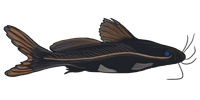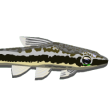Synodontis polli
-
StiffMeister
- Posts: 121
- Joined: 17 Dec 2003, 14:20
- Location 1: North of the Netherlands
- Interests: duh....
Synodontis polli
Anybody know anything about this fish? how to keep them and social stuff?? any info is cool...
- Dinyar
- Posts: 1286
- Joined: 31 Dec 2002, 00:34
- My articles: 3
- My images: 226
- My catfish: 10
- My cats species list: 3 (i:10, k:0)
- Spotted: 94
- Location 1: New York, NY, USA
- Interests: Mochokidae, Claroteidae, Bagridae, Malepteruridae, Chacidae, Heteropneustidae, Clariidae, Sisoridae, Loricariiadae
Species: Synodontis polli
Described by: Gosse. Nomen novum for Synodontis eurystomus Matthes, 1959, preoccupied by Synodontis eurystomus Pfeffer, 1889.
Described Year: 1982
Type Localities: Luhanga, Makabola, Kashekezi, Bemba, Kalungwe
Original Placement? Yes
Etymology: Named after Max Poll, a Belgian ichthyologist who worked extensively with fish from Lake Tanganyika and the Congo drainage
Pronunciation: sin-oh-dont-iss pole-ee
Size: 148 mm TL
Sexing: Males are larger and more robust than females. Can be sexed by genital papilla, as per other Synodontis spp.
Identification: Mouth wide, hence the original name of Synodontis eurystomus, which means "wide mouth". Cusp on dorsal edge of humeral process. Adult males are a chocolate brown with numerous black spots. Dull white edging on posterior edges of fins. Barbels short. Juveniles have a lighter coloration and somewhat brighter fin edging.
Origin: Lake Tanganyika. Although the type specimens are from Burundian waters, the species appears to be widely distributed around the lake, with some regional variation in appearance. Schraml [DATZ, 2003] reports possible S. polli variant from Lake Mweru.
Min. pH: 7.8
Max. pH: 9.2
Min. Temp. (°C): 23
Max. Temp.(°C): 29
Other Water: Clean, stable, hard water conditions, as per other Lake Tanganyika Synodontis. Strong current not necessary, but tolerated.
Feeding: Ominivore, with a preference for meaty foods. Will readily take flake foods, but should be fed a varied diet, supplemented by frozen and live foods. While spirulina is easily accepted, unlike S. multipunctatus, S. petricola, S. granulosus and even S. dhonti, S. polli will not eat vegetables such as cucumber, zucchini, etc. Plants are untouched.
Compatibility: Compatible with most Rift Lake catfish, cîchlids and mastacembelids. All except fry and very tiny fish are likely to be safe. Adult males may fight when first introduced, but aggression ceases once dominance and territories are established.
Furniture: Best kept in larger tanks. Furnish with rocky hiding places. Plants such as Vallisneria are optional.
Breeding: Many reports, but none confirmed. Upon investigation, reported spawnings have been of species other than S. polli.
Described by: Gosse. Nomen novum for Synodontis eurystomus Matthes, 1959, preoccupied by Synodontis eurystomus Pfeffer, 1889.
Described Year: 1982
Type Localities: Luhanga, Makabola, Kashekezi, Bemba, Kalungwe
Original Placement? Yes
Etymology: Named after Max Poll, a Belgian ichthyologist who worked extensively with fish from Lake Tanganyika and the Congo drainage
Pronunciation: sin-oh-dont-iss pole-ee
Size: 148 mm TL
Sexing: Males are larger and more robust than females. Can be sexed by genital papilla, as per other Synodontis spp.
Identification: Mouth wide, hence the original name of Synodontis eurystomus, which means "wide mouth". Cusp on dorsal edge of humeral process. Adult males are a chocolate brown with numerous black spots. Dull white edging on posterior edges of fins. Barbels short. Juveniles have a lighter coloration and somewhat brighter fin edging.
Origin: Lake Tanganyika. Although the type specimens are from Burundian waters, the species appears to be widely distributed around the lake, with some regional variation in appearance. Schraml [DATZ, 2003] reports possible S. polli variant from Lake Mweru.
Min. pH: 7.8
Max. pH: 9.2
Min. Temp. (°C): 23
Max. Temp.(°C): 29
Other Water: Clean, stable, hard water conditions, as per other Lake Tanganyika Synodontis. Strong current not necessary, but tolerated.
Feeding: Ominivore, with a preference for meaty foods. Will readily take flake foods, but should be fed a varied diet, supplemented by frozen and live foods. While spirulina is easily accepted, unlike S. multipunctatus, S. petricola, S. granulosus and even S. dhonti, S. polli will not eat vegetables such as cucumber, zucchini, etc. Plants are untouched.
Compatibility: Compatible with most Rift Lake catfish, cîchlids and mastacembelids. All except fry and very tiny fish are likely to be safe. Adult males may fight when first introduced, but aggression ceases once dominance and territories are established.
Furniture: Best kept in larger tanks. Furnish with rocky hiding places. Plants such as Vallisneria are optional.
Breeding: Many reports, but none confirmed. Upon investigation, reported spawnings have been of species other than S. polli.




